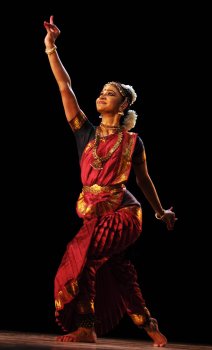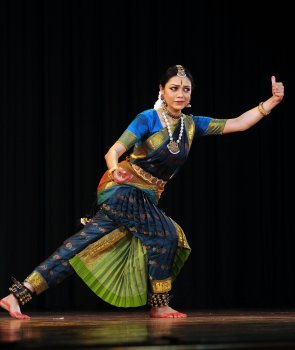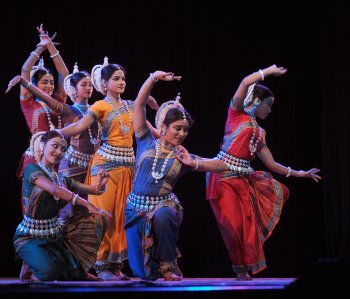
|   |

|   |
The Music Academy Dance Fest: Day 5 - Veejay Sai e-mail: vs.veejaysai@gmail.com Photos: Thanthoni January 14, 2012 The early bird Once in a while you get to see a good performance of a passionate young dancer or musician and you think how it is all not that bad as assumed and how there is still hope in the ever-shrinking world of Indian classical performing arts. Navia Natarajan is one such passionate dancer that rasikas can bank their confidence on. With enough grooming from her older guru Padmini Ramachandran and A Lakshman, Navia’s standing precedes her. Opening the fifth day of the academy’s festival, Navia’s performance proved her reputation right.  Navia started her performance with a Pushpanjali followed by a Devi Stuti in Pantuvaraali ragam. Her buoyancy on stage was visible from the very first item she presented. In Papanasam Sivan’s padavarnam “Swami naan undran adimai” in Nattaikurinji ragam, Navia’s precision came through in every jathi she performed. Her arresting teermanams and sincerity in abhinaya managed to successfully depict the fluidity of the Vazhuvoor school in which she has been trained. In ‘Yahi Madhava,’ Jayadeva Ashtapadi set to Sindhu Bhairavi ragam, Navia did justice to the portrayal of the nayika’s sthayibhava in spite of mispronunciations of lyrics by her vocalist Srikant. A small unconscious stretch of any syllable can change the complete meaning of the word, and hence the song itself. Seeing Navia’s dance one felt the academy wasn’t doing any justice by expecting up and coming youngsters like her to present a margam in one hour fifteen minutes. It is practically impossible for any sensible artiste to do that. Hopefully the academy will take note of their sense of timing slots when they prepare their schedules instead of leaving rasikas with incomplete dance recitals. Like the proverbial early bird, Navia can grow from strength to strength if she stays focused on her art. With a name like Navia, she is all set to bring about some much sought after newness into the dance scene and surely belongs to the successful generation-next in the world of Indian classical dance. Ah! That seductive Swarajathi! It feels a bit weird when the second performer for the morning turns out to be the guru of the first. One didn’t know if one had to be happy to see the guru-shishya performing back to back or wonder why was a senior seasoned dancer like A Lakshman plonked into a morning slot. Weird are the ways in which festival calendars take shape.  Lakshman began his performance with a brief pushpanjali and launched himself into the Swarajathi “Ye mandhayana raa na swami” in Huseni, a popular composition of the Tanjore Quartet. While the beginning was a bit slow, before anyone else could realize Lakshman managed to cast a spell on the entire hall of rasikas. Every sanchari he did, especially in the sahityam “ye mandu pettenu raa na swami,” he portrayed the various moods and emotions of the nayika with his effective abhinaya. He succeeded in convincing the attentive audiences that it did not matter if a male dancer characterized nayikas, so far as they did it so successfully as to blur all those lines of difference. Lakshman’s sanchari bhavas were a visual delight. His abhinaya kept all the rasikas’ eyes constantly swinging to the tangent of his movement on stage. This meticulous swarajathi turned out to be piece-de-resistance of not just his performance but of all that any male dancer performed during this festival. If at all dancer ever needs to perform this swarajathi, this should be the set standard to look up to, the way shringara must be evoked in this particular piece. Time flew like never before and rasikas were left craving for more. One could go on watching this swarajathi and not find a single repetitive movement nor feel the spectator-fatigue. Lakshman could easily be Chennai’s best senior male dancer if he toned himself to some perfection in his physicality. He certainly deserves to be in the prime slot on any festival calendar, so that genuine rasikas of the art form get to view a slice of the best. Lakshman had to cut short his full presentation owing to lack of time and end with a Jayadeva Ashtapadi. The audiences returned feeling a bit dejected about not having to see such a brilliant performer give a full recital. In a time when there are hundreds of aspiring boys genuinely taking to dance (many of them even giving up their plush salaried jobs to show their passion and commitment towards the art form) it is disheartening to see a prestigious festival of this stature slot only two male soloists in its entire schedule. Hopefully the next year’s season will accommodate more of these committed male dancers and encourage their art. When peacocks danced! The fifth day evening’s performances opened with a solo dance recital by Rama Vaidyanathan. Everyone in the margazhi season saw how brilliant she was in her latest work on Lal Ded which she presented at the Mad & Divine festival. For those of you who missed that, hope you get to watch it the next time Rama presents it, just to see a completely transformed Rama. At the Music Academy what one saw was classic Rama.  Dressed in a stunning blue color costume, Rama sashayed her way to open the evening with an allaripu and open Mayura hastas. The stage was transformed into a beautiful garden and all one could see was the way in which Rama pranced about across like a gorgeous peacock, in full bloom, like the monsoons were around the corner. With ever gesture of her face she evoked a new emotion. Oh Rama! How do you manage to reinvent yourself every time? What is the mysterious magic behind the spell you cast on rasikas at every sabha you perform? The rhythmic movements, the occasional leap, swift and graceful neck jerks, measured footsteps and hands quivering where needed, Rama portrayed the national bird’s grandeur with such charm. She went ahead to present a rare varnam in Reeti gowla ragam composed by the celebrated Thanjavur Vadivelu. Portraying the yearning nayika reaffirming her love for Lord Padmanabha, Rama’s exquisite artistry over the characterization with her sancharis couldn’t have been rendered better. The ragam brought out the million colors the varnam could etch and Rama became the medium of that blissful transaction. What a fantastic gift for Vadivelu on his 200th birthday celebrations! Like deer-tracks on freshly fallen snow, Rama took you through her performance with simplicity and élan. From there to “Yennathavam seithanai Yashoda” was a measured shift in how love is perceived and performed in both Shringara and Bhakti rasas. This is not a new item being presented on any stage at all. Even before the song started, many in the audience were seen humming Kaapi ragam. What was it about Rama’s dance that made a hall full of rasikas swoon over and track her every movement as she glided across the stage? With strong emotion and insightful portrayal of the characters, everyone in the hall was a step short of asking “Yenna thavam seithanai Rama?” to be blessed with such art. Forget Brahma and Indira being jealous of Yashoda’s luck, a hundred other dancers were probably even more jealous seeing Rama dance. Mellowing the tone of the evening like a gust of cool wind does on a hot summer day, Rama’s dance had many more rasikas in a sway of emotional tears. This was probably the best senior solo dance performance of this entire festival. With innovation as a strong subtext, fresh and subtle in her presentation, sincerity in her portrayal, Rama’s artistic integrity was matchless. Postcards from Orissa The last performance for the evening was a group show by Srjan founded by late Guru Kelucharan Mohapatra. His son Ratikant Mohapatra and his able team of dancers gave audiences a wonderful insight into different choreographic selections. ‘Yathagamanam,’ an excerpt from the Gita Govindam described the dashavataram of Lord Vishnu. It is an absolute pleasure to see this often repeated theme being performed in the original form. No other dance form can supplement what Odissi can, especially to Jayadeva’s classic literary masterpiece. It was a delightful experience to watch Ratikant play the role of Jataayu in ‘Jataayu Mokshya’ taken from Tulsidas’ Ramacharita Manas. Everyone is familiar with this episode and every other dance choreographer has possibly even attempted a production. But what came forth in the honesty of characterization was the poignancy of Jataayu with strong emotional undertones in Ratikant’s performance.  ‘Vande Mataram,’ our country’s national song was choreographed into an innocently magical choreographic presentation by none other than Kelubabu. Following his father’s footsteps, Ratikant gave the rasikas a slice of classic Odissi choreography. The final item ‘Allah’ took the hall by storm. For one, it was a live music concert recording of Aruna Sairam and the strength of Subramanya Bharatiyar’s lyrics to which the dancers were trained to perform. Set to a ragamalika, as the group of dancers went about the stage forming patterns, everyone in the audience familiar with this popular song were seen chanting ‘Allah allah.’ Did Aruna Sairam hijack a show without actually being physically present? Such was the power of this presentation that by the time the curtains came down, rasikas were seen leaving the hall tapping their fingers to the taalam of the song. Veejay Sai is a writer, editor and a culture critic. |